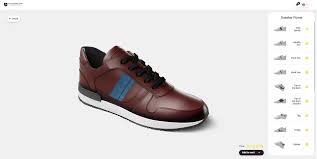Implementing a 3D Shoe Configurator: Best Practices and Considerations for Footwear Retailers

The shoe business is changing quickly because of new technologies and the desire for more unique shopping experiences. The 3D shoe configurator is one of the most important new technologies of the last few years. It lets customers create shoes in real time, giving them a fun and different way to interact with products. Using a 3D shoe maker can help shoe stores make customers happier, cut down on returns, and make more sales. You should follow some best practices and think about certain things when you use this technology in your online or offline experience.
1. Understand the Customer Journey
Before implementing a 3D shoe configurator, it’s crucial to understand how this tool fits into the overall customer journey. Customers today are increasingly expecting a seamless, interactive, and personalized shopping experience. A 3D shoe configurator can meet these expectations by allowing customers to explore different styles, colors, materials, and sizes. However, retailers need to ensure that the tool is intuitive and enhances the buying process rather than complicating it. It’s essential that the configurator is easily accessible and that the customization process is straightforward, making it easy for customers to visualize the end product.
2. User-Friendly Design
One of the most important aspects of a successful 3D shoe configurator is its design. It should be simple, intuitive, and visually appealing. Complex or confusing interfaces can drive potential customers away and lead to abandoned purchases. A clean, user-friendly interface allows customers to navigate through different customization options smoothly. It should also allow them to easily rotate the shoe, zoom in on details, and visualize changes in real time. To serve a wide range of people, make sure the tool works well on all kinds of devices, from desktops to smartphones.
3. High-Quality Visualization
The success of a 3D shoe configurator depends heavily on the quality of its visual output. Customers want to see accurate, high-resolution renderings of the shoes they are customizing. This level of detail gives customers confidence in their choices and helps them make purchasing decisions. Incorporating features like realistic lighting, shadows, and textures is essential to creating a lifelike experience. Retailers should also ensure that the configurator accurately reflects the true colors and materials of the shoes to avoid dissatisfaction once the product arrives.
4. Customization Options
The number of customization choices is very important when making a 3D shoe configurator. Different parts of the shoe, like the color of the top, sole, laces, and stitching, should be customizable for the customer. Giving customers a choice of fabrics, like leather, suede, or fabric, makes customizing even better. For more creativity, let people add their own touches, like monograms or custom designs. The more choices there are, the more customized the shoe is, which means that each customer gets a unique pair.
5. Integration with E-commerce Platform
A 3D shoe configurator should seamlessly integrate with your existing e-commerce platform. This integration ensures that customers can add their custom-designed shoes to their cart and proceed with a smooth checkout experience. The configurator should also be connected to your inventory management system so that the availability of materials and sizes is always up to date. Additionally, consider integrating a virtual try-on feature, where customers can upload their feet measurements or photos to see how the shoes would fit.
6. Performance and Speed
How well a 3D shoe maker works is very important to its success. It has to load fast, even on slower internet connections, and be able to handle the complex rendering that is needed to show 3D images in real time. Users can get annoyed by slow or laggy performance, which can make them leave their shopping cart. Optimize the configurator’s performance by using efficient coding techniques, image compression, and cloud-based rendering when necessary. Make sure that the back-end machinery of your website can handle the load, especially if you expect a lot of visitors.
7. Provide Clear Communication and Support
While a 3D shoe configurator offers an interactive experience, customers may have questions about the customization options, product details, or shipping. Providing clear communication through tooltips, FAQs, or a help section is essential. Additionally, offering live chat support or a customer service hotline can help address issues in real time, ensuring a smooth experience for the user.
8. Test and Optimize
Once the 3D shoe configurator is implemented, it’s important to continuously test and optimize the tool. Get comments from users to find ways to make things better, whether it’s the design, functionality, or ease of use. Monitor analytics to track customer engagement with the configurator and adjust the tool based on performance data. Regular updates and improvements will ensure that the configurator remains fresh, relevant, and effective in meeting customer needs.
Conclusion
Implementing a 3D shoe configurator is a powerful way for footwear retailers to enhance the customer experience, drive engagement, and ultimately increase sales. By focusing on a user-friendly design, high-quality visuals, a wide range of customization options, and seamless integration with your e-commerce platform, you can create a tool that customers will love to use. Remember to continually test and optimize the configurator to keep up with changing customer expectations and technological advancements. With the right approach, a 3D shoe configurator can help your brand stand out in the competitive footwear market.




